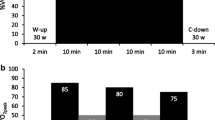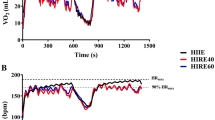Abstract
This preliminary study examined the effects of wearing an elevation training mask® 2.0 (ETM) during high-intensity interval training (HIIT) on the aerobic capacity of young men. Twenty-six young men were recruited and randomly divided into an experimental group (EG, n = 13) and a control group (CG, n = 13). The former performed HIIT on a running platform while wearing an ETM, and the latter performed HIIT only. Before and after the intervention, the following parameters were measured: exercise performance indicator is a 3000-m running test; aerobic capacity indicators are maximal oxygen uptake (VO2max), ventilatory anaerobic threshold (VT), and running economy (RE); the physiological indicators are blood, pulmonary function, and cardiac function. After 6 weeks of intervention, there were significant differences (p < 0.05) between the time and time × group interaction for the 3000-m running time. There were no significant differences (p > 0.05) in VO2max between the time and time × group interaction. The VT and RE demonstrated significant differences (p < 0.05) between the time and time × group interaction. Among the physiological indicators, pulmonary and cardiac function differed significantly (p < 0.05) be-tween the time and time × group interaction. Blood parameters showed no significant differences (p > 0.05) between the time points and time × group interaction. These preliminary results suggest that using ETM in conjunction with HIIT for 6 weeks increased young men’s aerobic performance much more than conventional HIIT. This effect may be attributed to the significantly improved respiratory function and cardiac function caused by the combination of ETM with HIIT.


Similar content being viewed by others
REFERENCES
Ross, R., Blair, S.N., Arena, R., et al., Importance of assessing cardiorespiratory fitness in clinical practice: a case for fitness as a clinical vital sign: a scientific statement from the American Heart Association, Circulation, 2016, vol. 134, no. 24. e653
Billat, L.V., Interval training for performance: a scientific and empirical practice: special recommendations for middle- and long-distance running: II. Anaerobic interval training, Sports Med., 2001, vol. 31, no. 2, p. 75.
Laursen, P.B. and Jenkins, D.G., The scientific basis for high-intensity interval training: optimising training programmes and maximising performance in highly trained endurance athletes, Sports Med., 2002, vol. 32, no. 1, p. 53.
Dick, F.W., Training at altitude in practice, Int. J. Sports Med., 1992, vol. 13, suppl. 1, p. S203.
Biggs, N.C., England, B.S.; Turcotte, N.J., et al., Effects of simulated altitude on maximal oxygen uptake and inspiratory fitness, Int. J. Exerc. Sci., 2017, vol. 10, no. 1, p. 127.
Warren, B., Spaniol, F. and Bonnette, R., The effects of an elevation training mask on VO2max of male reserve officers training corps cadets, Int. J. Exerc. Sci., 2017, vol. 10, no. 1, p. 37.
Bassett, D.R. and Howley, E.T., Limiting factors for maximum oxygen uptake and determinants of endurance performance, Med. Sci. Sports Exerc., 2000, vol. 32, no. 1, p. 70.
Porcari, J.P., Probst, L., Forrester, K., et al., Effect of wearing the elevation training mask on aerobic capacity, lung function, and hematological variables, J. Sports Sci. Med., 2016, vol. 15, no. 2, p. 379.
Segizbaeva, M. and Aleksandrova, N., Effect of wearing the Elevation Training Mask 2.0 on pulmonary and respiratory muscles function, Proceedings of International Congress 2018—Innovations in Equipment and Their Application, European Respiratory Society, 2018, p. PA3402.
Durussel, J., Ross, R., Kodi, P.R., et al., Precision of the optimized carbon monoxide rebreathing method to determine total haemoglobin mass and blood volume, Eur. J. Sport Sci., 2013, vol. 13, no. 1, p. 68.
Devereux, G., Le Winton, H.G., Black, J., and Beato, M., Effect of a high-intensity short-duration cycling elevation training mask on VO2max and anaerobic power: a randomized controlled trial, Biol. Sports, 2022, vol. 39, no. 1, p. 181.
Boyle, K.G., Napoleone, G., Ramsook, A.H., et al., Effects of the Elevation Training Mask® 2.0 on dyspnea and respiratory muscle mechanics, electromyography, and fatigue during exhaustive cycling in healthy humans, J. Sci. Med. Sport, 2022, vol. 25, no. 2, p. 167.
Volianitis, S., McConnell, A.K., Koutedakis, Y., et al., Inspiratory muscle training improves rowing performance, Med. Sci. Sports Exerc., 2001, vol. 33, no. 5, p. 803.
Katayama, K., Goto, K., Ohya, T., et al., Effects of respiratory muscle endurance training in hypoxia on running performance, Med. Sci. Sports Exerc., 2019, vol. 51, no. 7, p. 1477.
Roberts, A.D., Clark, S.A., Townsend, N.E., et al., Changes in performance, maximal oxygen uptake and maximal accumulated oxygen deficit after 5, 10 and 15 days of live high:train low altitude exposure, Eur. J. A-ppl. Physiol., 2003, vol. 88, nos. 4−5, p. 390. https://doi.org/10.1007/s00421-002-0720-3
Saunders, P.U., Pyne, D.B., Telford, R.D., and Hawley, J.A., Factors affecting running economy in trained distance runners, Sports Med., 2004, vol. 34, no. 7, p. 465.
Sperlich, B., Fricke, H., de Marées, M., et al., Does respiratory muscle training increase physical performance? Mil. Med., 2009, vol. 174, no. 9, p. 977.
Álvarez-Herms, J., Julià-Sánchez, S., Corbi, F., et al., Putative role of respiratory muscle training to improve endurance performance in hypoxia: a review, Front. Physiol., 2019, vol. 9, p. 1970.
Fernández-Lázaro, D., Gallego-Gallego, D., Corchete, L.A., et al., Inspiratory muscle training program using the PowerBreath®: does it have ergogenic potential for respiratory and/or athletic performance? A systematic review with meta-analysis, Int. J. Environ. Res. Public. Health, 2021, vol. 18, no. 13, p. 6703.
Kido, S., Nakajima, Y., Miyasaka, T., et al., Effects of combined training with breathing resistance and sustained physical exertion to improve endurance capacity and respiratory muscle function in healthy young adults, J. Phys. Ther. Sci., 2013, vol. 25, no. 5, p. 605.
Hung, K.-C., Chung, H.-W., Yu, C.C.-W., et al., Effects of 8-week core training on core endurance and running economy, PLoS One, 2019, vol. 14, no. 3. e0213158
Tong, T.K., McConnell, A.K., Lin, H., et al., “Functional” inspiratory and core muscle training enhances running performance and economy, J. Strength Cond. Res., 2016, vol. 30, no. 10, p. 2942.
Nobre e Souza, M.Â., Lima, M.J.V., Martins, G.B., et al., Inspiratory muscle training improves antireflux barrier in GERD patients, Am. J. Physiol.: Gastrointest. Liver Physiol., 2013, vol. 305, no. 11, p. G862.
Kaminski, D.M., Schaan, B.D., da Silva, A.M.V., et al., Inspiratory muscle training in patients with diabetic autonomic neuropathy: a randomized clinical trial, Clin. Auton. Res., 2015, vol. 25, no. 4, p. 263.
Aslan, S.C., Randall, D.C., Krassioukov, A.V., et al., Respiratory training improves blood pressure regulation in individuals with chronic spinal cord injury, Arch. Phys. Med. Rehabil., 2016, vol. 97, no. 6, p. 964.
Elstad, M. and Walløe, L., Heart rate variability and stroke volume variability to detect central hypovolemia during spontaneous breathing and supported ventilation in young, healthy volunteers, Physiol. Meas., 2015, vol. 36, no. 4, p. 671.
Dunham, C. and Harms, C.A., Effects of high-intensity interval training on pulmonary function, Eur. J. Appl. Physiol., 2012, vol. 112, no. 8, p. 3061.
Segizbaeva, M.O. and Aleksandrova, N.P., Effect of the Elevation Training Mask on the functional outcomes of the respiratory muscles, Hum. Physiol., 2018, vol. 44, no. 6, p. 656.
Roman, M.A., Rossiter, H.B., and Casaburi, R., Exercise, ageing and the lung, Eur. Respir. J., 2016, vol. 48, no. 5, p. 1471.
Roels, B., Millet, G.P., Marcoux, C.J.L., et al., Effects of hypoxic interval training on cycling performance, Med. Sci. Sports Exerc., 2005, vol. 37, no. 1, p. 138.
ACKNOWLEDGMENTS
The authors thank all the subjects who participated in this study.
Funding
This research was funded by the Chinese Universities Scientific Fund (2022YB015) and China Yan’an University and the Natural Science Foundation of Shaanxi Province (YDBK2018-29 and 2021JQ-625 to X.Y.).
Author information
Authors and Affiliations
Contributions
Conceptualization, Haonan Tian and Jun Wang; Data curation, Jieming Lu; Formal analysis, Haonan Tian and Ruotong Wang; Funding acquisition, Yang Xiang and Jun Wang; Investigation, Haonan Tian, Jieming Lu, Ruotong Wang, Feng Zhang and Bozhao Qi; Methodology, Haonan Tian, Jieming Lu, Yang Xiang and Jun Wang; Project administration, Jun Wang; Resources, Jieming Lu and Jun Wang; Software, Haonan Tian and Jieming Lu; Supervision, Yang Xiang and Jun Wang; Validation, Jun Wang; Visualization, Haonan Tian; Writing—original draft, Haonan Tian; Writing—review & editing, Haonan Tian and Jun Wang. All authors have read and agreed to the published version of the manuscript.
Corresponding author
Ethics declarations
COMPLIANCE WITH ETHICAL STANDARDS
Before the initiation of the study, all participants received an explanation of the procedure and the risks that would later be faced in their participation, and they provided informed consent to participate in this study. The study was approved by the Ethics Committee of Beijing Sport University (2021186H, approved June 2021), and all procedures were in accordance with the Declaration of Helsinki.
CONFLICT OF INTEREST
The authors state no conflict of interest with respect to the research, authorship, and/or publication of this article.
Rights and permissions
About this article
Cite this article
Tian, H., Lu, J., Xiang, Y. et al. Effects of 6 Week Elevation Training Mask with High-Intensity Interval Training on the Aerobic Capacity of Young Men. Hum Physiol 49, 402–410 (2023). https://doi.org/10.1134/S0362119723600029
Received:
Revised:
Accepted:
Published:
Issue Date:
DOI: https://doi.org/10.1134/S0362119723600029




